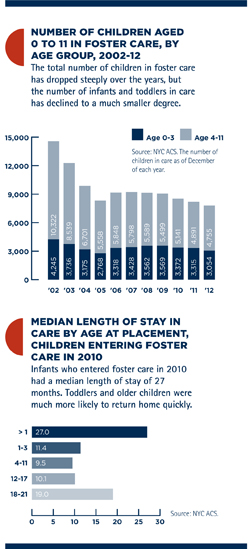Learning How Babies’ Brains Grow
 In the past two decades, researchers have learned a great deal about how to protect children from the harm caused by early trauma or neglect. That knowledge does little good, however, if it doesn't reach the people caring for the kids who are most at risk. For babies and very young children in New York City’s foster care system, that means not only the foster parents who take them in at times of crisis, but also the birth parents to whom most kids eventually go home.
In the past two decades, researchers have learned a great deal about how to protect children from the harm caused by early trauma or neglect. That knowledge does little good, however, if it doesn't reach the people caring for the kids who are most at risk. For babies and very young children in New York City’s foster care system, that means not only the foster parents who take them in at times of crisis, but also the birth parents to whom most kids eventually go home.
Two years ago, the city’s child welfare administration hired a researcher named Philip Fisher to develop a program that would help caregivers understand how baby and toddler brains grow. Out of the profoundly complicated and rapidly expanding universe of thought on infant neurobiology (and along with scientists at Harvard University’s Center on the Developing Child) Fisher extracted a single concept that he considers to be the basic unit of infant development.
The idea is simple: It is in babies’ nature—in their basic wiring— to initiate interaction with the adults who take care of them. What determines a baby’s fate is whether she has a caregiver who responds. If she does, and especially if the responses are consistent and nurturing, her brain will make connections between sounds, expressions and objects, stimulating her neural circuitry to grow in the sturdy configurations that buttress future thinking and learning. Her relationship with her caregiver will become stronger, freeing her to explore her world and initiate further interactions—and so the cycle is set up to repeat itself.
“The underlying guiding principle is that healthy development is preprogrammed to occur,” Fisher says. “But it requires the right kinds of input.” When caregivers give that input, they create a kind of developmentally stimulating interaction that Fisher and his collaborators call ‘serve and return.’
In order to teach parents how to recognize babies’ serves and give them appropriate returns, Fisher developed a series of brief video clips, each designed to demonstrate the micro-moments of responsive parenting. In one, a mom picks up her baby. Through a succession of freeze-frames, we watch the baby begin to fuss. When his mother reaches for him, we see him look for her face. His eyes brighten and he kicks with excitement. The mother makes eye contact, speaking in a gentle voice as she takes the baby into her arms.
The interaction lasts less than half a minute. It’s one that any parent in the room—even one who has lost custody of her child—has almost certainly experienced. Which is precisely the point, says Kristen Greenley, who manages Fisher’s video project. A basic principle of the program is that if caregivers understand why their nurturing is so important—if they learn to see themselves as a powerful, positive force in their children’s development—they will nurture more and, as a result, build stronger relationships and raise healthier kids. “We’re showing them: You’re already doing this,” Greenley says. “Pay attention to when you’re doing it. It’s really good for your child.”
The city’s Administration for Children’s Services (ACS) has adopted Fisher’s work as one piece of a larger project to improve and standardize services for families in the child welfare system. Under the broader initiative, which goes by the umbrella name of ChildSuccessNYC, parents attend a series of workshops, which are run as a cross between a parenting class and a support group. Facilitators instruct caregivers on developmental stages (what parents can reasonably expect from their children and when) and on parenting strategies intended to nurture children’s development at each stage. Caregivers are assigned to practice the strategies at home and have regular, individual check-ins with caseworkers about their progress.
The workshops adhere to what are known as “evidence based” models: They were tested in controlled trials involving large cohorts of foster kids, with results that showed better outcomes than those of kids whose caregivers weren't enrolled in the programs. However, the programs were developed for parents with children over age 5—kids whose problems are often more obvious than those of babies and toddlers. In New York City, foster care agencies are using Fisher’s video clips in order to fill the gap.
So far, five of the city’s foster care agencies have been trained to offer the ChildSuccessNYC workshops. More than 400 foster parents and nearly 350 birth parents have completed them. Close to half have children under age 5.
In other versions of Fisher’s program, being implemented elsewhere, facilitators visit parents in their homes and videotape them interacting with their own children. Then they isolate examples of serve and return and play them back to parents in individual sessions, pointing out the connection they see in those moments. Fisher says that individual video screenings are the optimal way to run the program, but that they would have been too costly and time-consuming to meet New York City’s requirements. “We have to be adaptable,” he says. “One of the things we’re waiting to see is, in the context of larger groups designed for older kids, how much will the infant material be infused? How much do the techniques get employed?”
ACS is working with an independent evaluator to assess the impact of the programs. The results will be available sometime next year.
